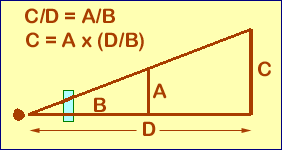| STEP 4. VARIABLE TARGET DISTANCE: Our "low-tech"
surveying method, as outlined so far, will work well when the target object is 2 meters
away. But, it would clearly be advantageous to improve the technique so that a target at
any distance could be measured. This is certainly the case for the Museum field trip
because the dinosaur specimens you will be working with will not be 2m away from you.
|
| We can come up with a solution
to this need by revisiting high school geometry, specifically similar triangles. In the
sketch at right, the small triangle and large triangle are clearly similar to each other.
Thus, the ratio of equivalent legs of the triangles will be constant, or C/D = A/B, as noted
in the sketch. We can rewrite this relation in terms of C, also as noted in the sketch.
|  |
| This is a very useful relation because we can use it to generalize
our surveying technique to include target objects at any distance. To see this, if it isn't
already obvious, consider an object a distance of D away from you (the dot in the sketch
above is your eye). The target object has a height C, which you want to measure. B is the
calibration (wall) distance, and the blue rectangle in the sketch is your
hand-held ruler. The line of sight from your eye to the bottom of the obect forms the lower
legs (B and D) of the two triangles, and the lower intercept mark on your ruler. Your line
of sight to the top of C forms the hypoteneuse of the two triangles, and the upper intercept
on your ruler. Suppose 5 divisions on your hand held ruler are intercepted. You know from
your calibration that at the calibration distance of 2 m, 5 divisions = 50 cm. Thus, B =
2m; and A = 50cm = 0.5m. Suppose D = 8m. Then:
C = A x (D/B) = 0.5m x (8m/2m) = 2m.
The object's height (C) is thus 2 meters.
We can conclude from this example that as long as we know the
distance to the target object we are measuring, and we have done the calibration correctly,
we can get a reasonable estimate of the object's length.
|
|





